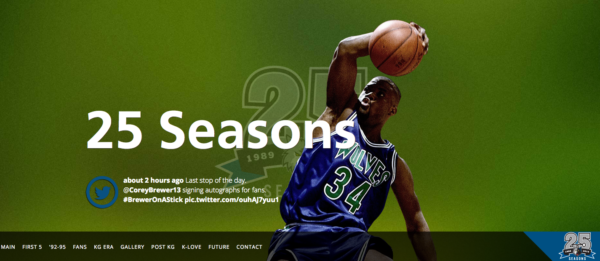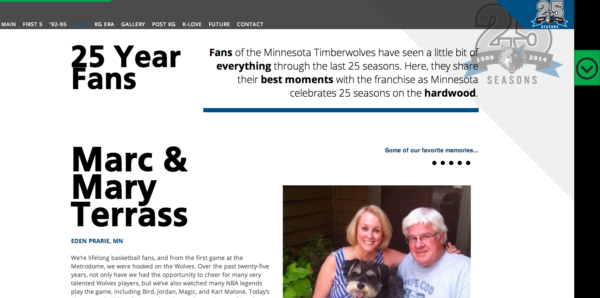Branding With Parallax Design: 5 Questions With The Minnesota Timberwolves
A powerful — and meaningful — site design is more important than ever; it takes less than two-tenths of a second for an online visitor to form an opinion about a brand. Expectations to be entertained and involved by online media are only rising, and one way to captivate an audience is to use parallax […]

What Is Parallax Design?
Parallax scrolling in Web design provides a multimedia experience that layers images that move in different speeds, creating an illusion that you are interacting as you scroll. The technique is used by media organizations and brands alike that want to tell an interactive story that visually captivates the viewer. Some have expressed that parallax scrolling is becoming overused; yet, brands such as Oakley, Nintendo and Peugeot have gone all out using it as a core digital strategy.
Recently, the Minnesota Timberwolves launched a parallax site to celebrate its 25th anniversary, and is possibly one of the only professional sports teams that have used this method. We asked Bob Stanke, Director of Interactive Services for the Timberwolves (also a speaker at last year’s SMX Social Media Conference) about making the branding decision to use parallax scrolling.
5 Questions With The Minnesota Timberwolves Director Of Interactive Services, Bob Stanke
Monica Wright: First of all, why parallax? Besides the benefit of improved storytelling, parallax designs present issues for SEO and analytics, and is not considered as a mobile-friendly format. It also can be slow to load. As a marketer, how did you make the decision to use this technique?
Bob Stanke: Every industry and the businesses inside of those industries have different measures of success. For our business, it is not all about SEO and analytics. It is about presenting an experience that is flashy and offers a bit of a “cool” factor. We could walk away with a million views in one day without any specific revenue-based data capture and still be okay with the fact that we reached so many visitors and told them our story. Sports has a reputation for producing great in-person experiences that then are translated to digital formats. The powerful images and interaction a parallax design offer make it perfect for sports and entertainment brands. The specific parallax design we used also offers a responsive element for mobile as well. We are especially happy with how the site shows up on an iPad.
Monica Wright: Other than views, what’s the metric for success? Is the goal to get the fans to share the story?
Bob Stanke: Getting fans to share their stories is key to our 25-season strategy, so that call-to-action in the site is important. Even more importantly is sharing the story of our past, present and future – something all of our fans have been a part of. This site is about connecting our fans and our team using a cutting-edge design.
Monica Wright: So why not use video, or a friendlier “embeddable” format?
Bob Stanke: Our competition already does video. And a “friendlier” format screams too much like doing what everyone else is doing. We wanted to break some barriers down and get out of our comfort zone by bringing fans something new.
Monica Wright: Why not launch a timeline on the official Timberwolves site?
Bob Stanke: The back-end of our existing site allows for only so much creative flexibility. It is not uncommon for sports teams to develop completely separate sites for campaigns like this. And each site tells a different story, and the best way to celebrate our 25th season deserved its own site.
Monica Wright: It looks awesome, but would you have done anything differently?
Bob Stanke: Like any new technology, there are bugs. We had a specific deadline to meet, so testing was limited. Certain browsers reacted differently, so we have to make certain changes to accommodate as broad a technology set as possible. Otherwise we are happy with how things turned out, but we do see this evolving over time.
Opinions expressed in this article are those of the guest author and not necessarily MarTech. Staff authors are listed here.
Related stories

